Wolfram Function Repository
Instant-use add-on functions for the Wolfram Language
Function Repository Resource:
Decorate an ArrayPlot with additional characters
ResourceFunction["CharacterArrayPlot"][array] generates an ArrayPlot of array and overlays values as textual symbols. |
| ColorRules | how to assign colors to array values |
| CharacterRules | how to assign characters to array values |
| CharacterStyleRules | how to assign styles to array values |
| Mesh | a boolean value for adding a border to cells |
| MeshStyle | how to style borders when Mesh is True |
Plot a numerical 2×2 array with colors and numbers:
| In[1]:= |
| Out[1]= | 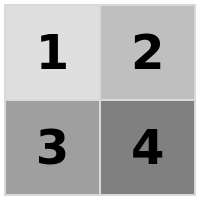 |
Adjust GrayLevel values and font sizes:
| In[2]:= | ![ResourceFunction["CharacterArrayPlot"][{{1, 2}, {3, 4}},
ColorRules -> {x_ :> GrayLevel[(x + 4)/8]},
"CharacterStyleRules" -> {x_ :> {36, Black}},
MeshStyle -> Black, ImageSize -> 100]](https://www.wolframcloud.com/obj/resourcesystem/images/e5c/e5cf81b3-13ef-4fdc-a29d-fb92d0ffbba0/75341dc9c56bf7dc.png) |
| Out[2]= | 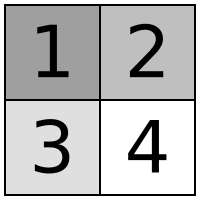 |
Exchange numbers for letters:
| In[3]:= | ![ResourceFunction["CharacterArrayPlot"][{{1, 2}, {3, 4}},
ColorRules -> {x_ :> GrayLevel[(x + 4)/8]},
"CharacterStyleRules" -> {x_ :> {36, Black}},
"CharacterRules" -> {1 -> "A", 2 -> "B", 3 -> "C", 4 -> "D"},
MeshStyle -> Black, ImageSize -> 100]](https://www.wolframcloud.com/obj/resourcesystem/images/e5c/e5cf81b3-13ef-4fdc-a29d-fb92d0ffbba0/3e02838292a42b7c.png) |
| Out[3]= | 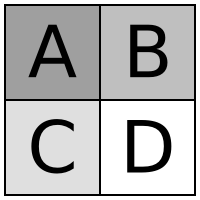 |
Add colors:
| In[4]:= | ![ResourceFunction["CharacterArrayPlot"][{{1, 2}, {3, 4}},
ColorRules -> {x_ :> Lighter[Hue[(x + 1)/6], .6]},
"CharacterStyleRules" -> {x_ :> {36, Lighter[Hue[(6 - x)/6], .6]}},
"CharacterRules" -> {1 -> "A", 2 -> "B", 3 -> "C", 4 -> "D"},
MeshStyle -> Directive[Gray, Thick], ImageSize -> 100]](https://www.wolframcloud.com/obj/resourcesystem/images/e5c/e5cf81b3-13ef-4fdc-a29d-fb92d0ffbba0/6952ad045bd2f8b1.png) |
| Out[4]= | 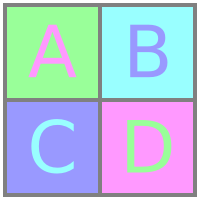 |
Plot a position in a game of tic-tac-toe, player X to win:
| In[5]:= | ![ResourceFunction[
"CharacterArrayPlot"][{{1, 2, 0}, {2, 0, 0}, {1, 0, 1}},
ColorRules -> {0 -> White, 1 -> Lighter[Orange, .5],
2 -> Lighter[Purple, .7]},
"CharacterStyleRules" -> {x_ :> {26, Black, Bold}},
"CharacterRules" -> {1 -> "X", 2 -> "O", 0 -> ""},
MeshStyle -> Directive[Thick, LightGray],
ImageSize -> 100, Frame -> True, FrameTicks -> False,
FrameStyle -> Directive[
Blend[{Orange, Red}, .3], Thickness[.05]]]](https://www.wolframcloud.com/obj/resourcesystem/images/e5c/e5cf81b3-13ef-4fdc-a29d-fb92d0ffbba0/4d49fd2e4e9afb94.png) |
| Out[5]= | 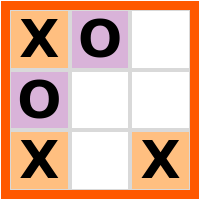 |
Make an even larger plot of randomly-sampled letters:
| In[6]:= | ![ResourceFunction["CharacterArrayPlot"][Partition[
RandomChoice[ToUpperCase /@ Alphabet[], 169], 13],
ImageSize -> 500]](https://www.wolframcloud.com/obj/resourcesystem/images/e5c/e5cf81b3-13ef-4fdc-a29d-fb92d0ffbba0/105110ed6dc07d0f.png) |
| Out[6]= | 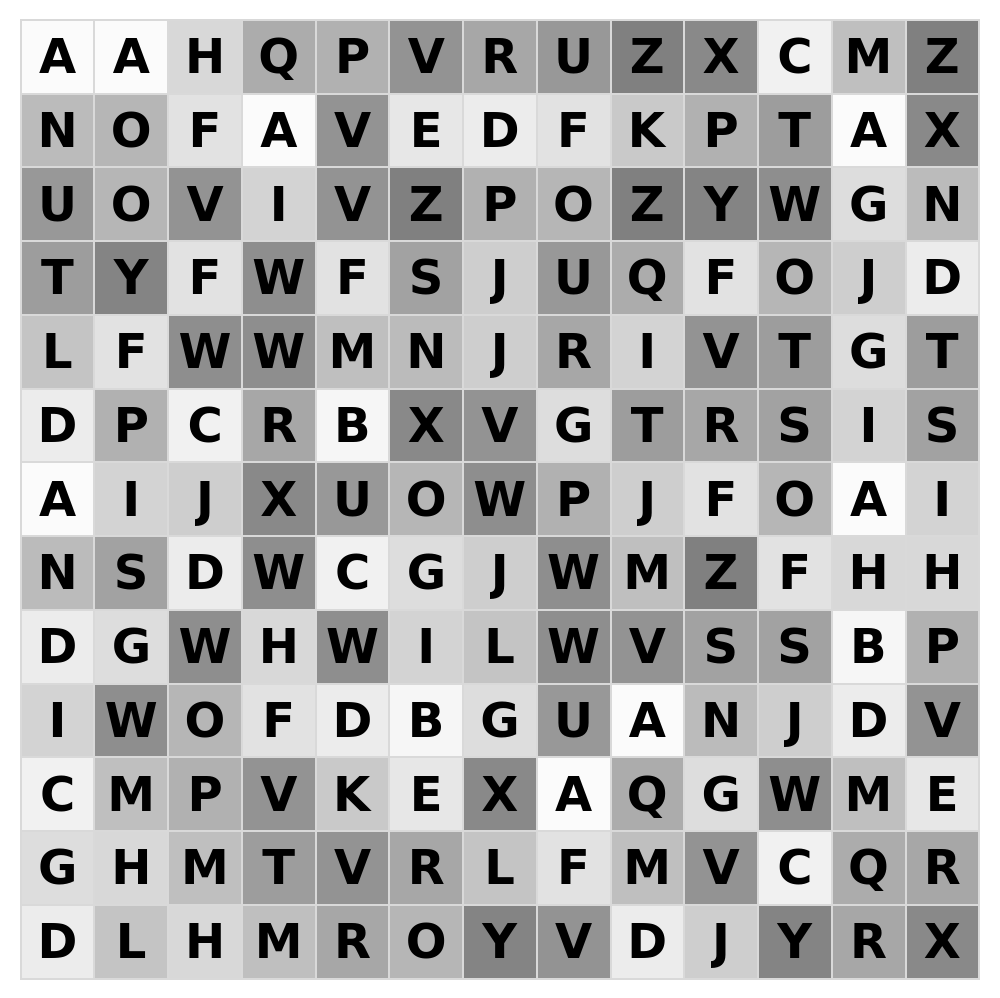 |
CharacterArrayPlot is designed to work well with FromCharacterCode:
| In[7]:= | ![With[{chessBoard = MapIndexed[
If[Mod[Total[#2], 2] == 0, #1, -#1] &,
Join[{{9820, 9822, 9821, 9819, 9818, 9821, 9822, 9820},
Table[9823, {8}]}, ConstantArray[1, {4, 8}],
{Table[9817, {8}],
{9814, 9816, 9815, 9813, 9812, 9815, 9816, 9814}}], {2}]},
ResourceFunction["CharacterArrayPlot"][chessBoard,
ColorRules -> {x_ :> Association[
1 -> Lighter[Yellow, .6],
-1 -> Lighter[Orange, .6]][Sign[x]]},
"CharacterStyleRules" -> {x_ :> {26, Black}},
"CharacterRules" -> {1 -> "", -1 -> "", x_ :> FromCharacterCode[Abs[x]]},
MeshStyle -> Directive[Gray, Thick]]]](https://www.wolframcloud.com/obj/resourcesystem/images/e5c/e5cf81b3-13ef-4fdc-a29d-fb92d0ffbba0/0981ab4ee410ffa2.png) |
| Out[7]= |  |
Or if you'd rather play a game of Xiangqi (象棋):
| In[8]:= | ![With[{xiangqiBoard = {{36554, 39340, 35937, -22763,
-23558, -22763, 35937, 39340, 36554},
Join[ConstantArray[1, 3], ConstantArray[-1, 3], ConstantArray[1, 3]],
{1, 30770, 1, -1, -1, -1, 1, 30770, 1},
{21330, 1, 21330, 1, 21330, 1, 21330, 1, 21330},
ConstantArray[0, 9], ConstantArray[0, 9],
{20853, 1, 20853, 1, 20853, 1, 20853, 1, 20853},
{1, 28846, 1, -1, -1, -1, 1, 28846, 1},
Join[ConstantArray[1, 3], ConstantArray[-1, 3], ConstantArray[1, 3]],
{20453, 20620, 30456, -20181,
-24069, -20181, 30456, 20620, 20453}},
black = First[ToCharacterCode[Last[#]]] & /@ {"General" -> "将",
"Advisor" -> "士", "Elephant" -> "象", "Horse" -> "馬",
"Rook" -> "車", "Cannon" -> "砲", "Pawn" -> "卒"},
red = First[ToCharacterCode[Last[#]]] & /@ {"General" -> "帅",
"Advisor" -> "仕", "Elephant" -> "相", "Horse" -> "傌",
"Rook" -> "俥", "Cannon" -> "炮", "Pawn" -> "兵"}},
ResourceFunction["CharacterArrayPlot"][xiangqiBoard,
ColorRules -> {x_ :> Association[
0 -> Lighter[Blue, .7],
1 -> Lighter[Blend[{Brown, Green}, .35], .6],
-1 -> Lighter[Brown, .6]][Sign[x]]},
"CharacterStyleRules" -> Flatten[{
{# -> {26, Darker@Red}, -# -> {26, Darker@Red}} & /@ red,
{# -> {26, Black}, -# -> {26, Black}} & /@ black,
{0 -> {15, LightBlue}}}],
"CharacterRules" -> {1 -> "", 0 -> "~", x_ :> FromCharacterCode[Abs[x]]},
MeshStyle -> Directive[Gray, Thick]]]](https://www.wolframcloud.com/obj/resourcesystem/images/e5c/e5cf81b3-13ef-4fdc-a29d-fb92d0ffbba0/3c806aa37fcb4c73.png) |
| Out[8]= |  |
CharacterArrayPlot is not designed automatically scale text:
| In[9]:= | ![ResourceFunction["CharacterArrayPlot"][{{1, 2}, {3, 4}},
ColorRules -> {x_ :> Lighter[Hue[(x + 1)/6], .6]},
"CharacterStyleRules" -> {x_ :> {12, Lighter[Hue[(6 - x)/6], .6]}},
"CharacterRules" -> {1 -> "A", 2 -> "B", 3 -> "C", 4 -> "D"},
MeshStyle -> Directive[Gray, Thick], ImageSize -> 30 #] & /@ Range[3]](https://www.wolframcloud.com/obj/resourcesystem/images/e5c/e5cf81b3-13ef-4fdc-a29d-fb92d0ffbba0/003d28a09ad057b2.png) |
| Out[9]= | 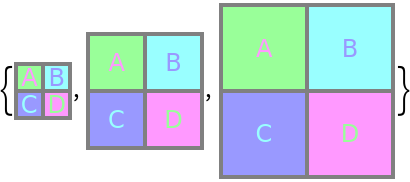 |
Using more than one character per cell can cause overflow:
| In[10]:= | ![ResourceFunction["CharacterArrayPlot"][{{1, 2}, {3, 4}},
ColorRules -> {x_ :> Lighter[Hue[(x + 1)/6], .6]},
"CharacterStyleRules" -> {x_ :> {20, Lighter[Hue[(6 - x)/6], .6]}},
"CharacterRules" -> {1 -> "A", 2 -> "BBBBBBBBB", 3 -> "C", 4 -> "D"},
MeshStyle -> Directive[Gray, Thick], ImageSize -> 100]](https://www.wolframcloud.com/obj/resourcesystem/images/e5c/e5cf81b3-13ef-4fdc-a29d-fb92d0ffbba0/739940635937968e.png) |
| Out[10]= |  |
Plot the initial condition of the "Moving Day" sliding block puzzle:
| In[11]:= | ![ResourceFunction["CharacterArrayPlot"][{{1, 2, 3}, {4, 0, 5}},
ColorRules -> MapIndexed[(#2[[1]] - 1) -> #1 &,
Lighter /@ {White, Hue[0.08, 1, 0.97], Hue[0.61, 0.46, 0.89], Hue[
0.23, 0.71, 0.79], Hue[0.81, 0.51, 0.85], Hue[0.53, 0.62, 0.89]}],
"CharacterStyleRules" -> {x_ :> {10, Black}},
"CharacterRules" -> {0 -> "\[Bullet]", x_ :> x},
MeshStyle -> Directive[Gray, Thick], ImageSize -> 65]](https://www.wolframcloud.com/obj/resourcesystem/images/e5c/e5cf81b3-13ef-4fdc-a29d-fb92d0ffbba0/6faeb466173fd91d.png) |
| Out[11]= |
Plot possible moves as a branching Graph:
| In[12]:= | ![With[{g0 = Graph[{{1, 2, 3}, {4, 0, 5}} -> # & /@ {
{{1, 2, 3}, {4, 5, 0}},
{{1, 2, 3}, {0, 4, 5}},
{{1, 0, 3}, {4, 2, 5}}}, EdgeStyle -> Gray]}, Graph[g0,
VertexSize -> 1, PerformanceGoal -> "Quality",
GraphLayout -> "LayeredDigraphEmbedding",
VertexShapeFunction -> (
Inset[ResourceFunction["CharacterArrayPlot"][#2,
ColorRules -> MapIndexed[(#2[[1]] - 1) -> #1 &,
Lighter /@ {White, Hue[0.08, 1, 0.97], Hue[0.61, 0.46, 0.89],
Hue[0.23, 0.71, 0.79], Hue[0.81, 0.51, 0.85], Hue[
0.53, 0.62, 0.89]}],
"CharacterStyleRules" -> {x_ :> {10, Black}},
"CharacterRules" -> {0 -> "\[Bullet]", x_ :> x},
MeshStyle -> Directive[Gray, Thick]
], #1, Center, #3] &)]]](https://www.wolframcloud.com/obj/resourcesystem/images/e5c/e5cf81b3-13ef-4fdc-a29d-fb92d0ffbba0/3906c478f849149f.png) |
| Out[12]= | 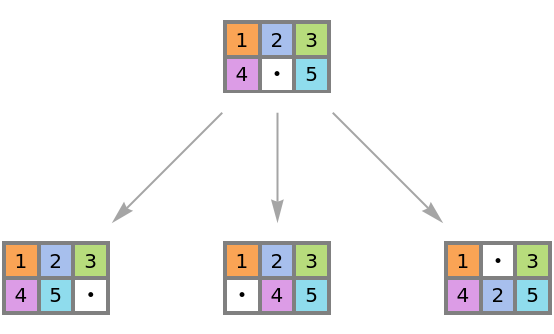 |
This work is licensed under a Creative Commons Attribution 4.0 International License